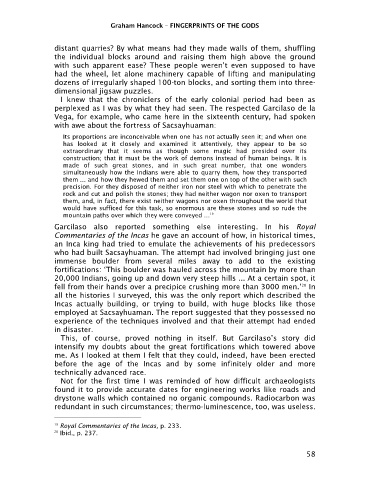Page 60 - Fingerprints of the Gods by Graham Hancock
P. 60
Graham Hancock – FINGERPRINTS OF THE GODS
distant quarries? By what means had they made walls of them, shuffling
the individual blocks around and raising them high above the ground
with such apparent ease? These people weren’t even supposed to have
had the wheel, let alone machinery capable of lifting and manipulating
dozens of irregularly shaped 100-ton blocks, and sorting them into three-
dimensional jigsaw puzzles.
I knew that the chroniclers of the early colonial period had been as
perplexed as I was by what they had seen. The respected Garcilaso de la
Vega, for example, who came here in the sixteenth century, had spoken
with awe about the fortress of Sacsayhuaman:
Its proportions are inconceivable when one has not actually seen it; and when one
has looked at it closely and examined it attentively, they appear to be so
extraordinary that it seems as though some magic had presided over its
construction; that it must be the work of demons instead of human beings. It is
made of such great stones, and in such great number, that one wonders
simultaneously how the Indians were able to quarry them, how they transported
them ... and how they hewed them and set them one on top of the other with such
precision. For they disposed of neither iron nor steel with which to penetrate the
rock and cut and polish the stones; they had neither wagon nor oxen to transport
them, and, in fact, there exist neither wagons nor oxen throughout the world that
would have sufficed for this task, so enormous are these stones and so rude the
mountain paths over which they were conveyed ...
19
Garcilaso also reported something else interesting. In his Royal
Commentaries of the Incas he gave an account of how, in historical times,
an Inca king had tried to emulate the achievements of his predecessors
who had built Sacsayhuaman. The attempt had involved bringing just one
immense boulder from several miles away to add to the existing
fortifications: ‘This boulder was hauled across the mountain by more than
20,000 Indians, going up and down very steep hills ... At a certain spot, it
fell from their hands over a precipice crushing more than 3000 men.’ In
20
all the histories I surveyed, this was the only report which described the
Incas actually building, or trying to build, with huge blocks like those
employed at Sacsayhuaman. The report suggested that they possessed no
experience of the techniques involved and that their attempt had ended
in disaster.
This, of course, proved nothing in itself. But Garcilaso’s story did
intensify my doubts about the great fortifications which towered above
me. As I looked at them I felt that they could, indeed, have been erected
before the age of the Incas and by some infinitely older and more
technically advanced race.
Not for the first time I was reminded of how difficult archaeologists
found it to provide accurate dates for engineering works like roads and
drystone walls which contained no organic compounds. Radiocarbon was
redundant in such circumstances; thermo-luminescence, too, was useless.
19 Royal Commentaries of the Incas, p. 233.
20 Ibid., p. 237.
58

